Hydrangeas are one of the world’s most popular ornamental flowers for a reason. Incredibly eye-catching and versatile, they bring vitality and charm to glamorous celebrations, spiritual ceremonies, and small, intimate occasions alike.
Known for its range of exciting colours that vary from a dazzling white to all shades of pink, blue, purple, and red, the hydrangea can also completely change the colour of its flowers from one season to the next – giving a whole new look to your garden!
Hydrangeas are especially beloved by gardeners because they thrive in a wide range of environments, are easy to breed, and produce some of the largest and most vibrant blooms of flowers with little effort.
So how can you grow and take care of hydrangeas in your garden? Let’s explore the wonderful world of hydrangeas!
Hydrangea Macrophylla | Bigleaf Hydrangea
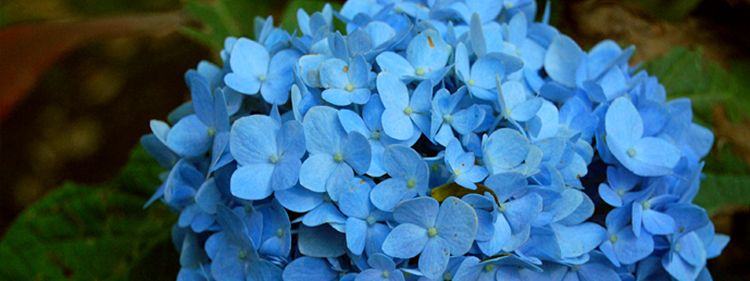
This is the most popular hydrangea species among gardening enthusiasts. The reason is that its flowers have the thrilling ability to change colours from one season to the next depending on the pH level of the soil. The bloom of the Hydrangea Macrophylla, commonly known as Bigleaf Hydrangea, can range from white to all shades of blue, pink, and purple, and some of its hybrids can even produce blooms with three different colours at the same time.
If your soil is neutral and alkaline, your Bigleaf Hydrangea flowers will be pink for that season, and if it is acidic, then its flowers will be blue. Some gardeners recommend using homemade methods, such as mixing coffee grounds and compost into the mulch or pouring a bit of vinegar or lemon juice in the soil to change it from alkaline to acid. These methods have mixed results. For a more certain outcome, use sulphur to acidify your soil or agricultural lime to alkalise it. Too much of either one will harm your shrub, so apply in amounts suited to the type of soil you have in your garden.
The Bigleaf Hydrangea is native to Japan, China, and Korea, and its varieties are categorised into two main groups: mophead and lacecap. Mopheads are the more popular of the two because they produce huge, round blooms entirely filled with incredibly eye-catching sterile flowers. While Lacecaps, also known as Gaku-ajisai in Japanese, are flatter in shape and bear smaller fertile flowers in the middle that are surrounded by the larger sterile flowers. Bigleaf hydrangeas typically grow to between 1.2 to 1.8 metres, although some varieties can grow taller.
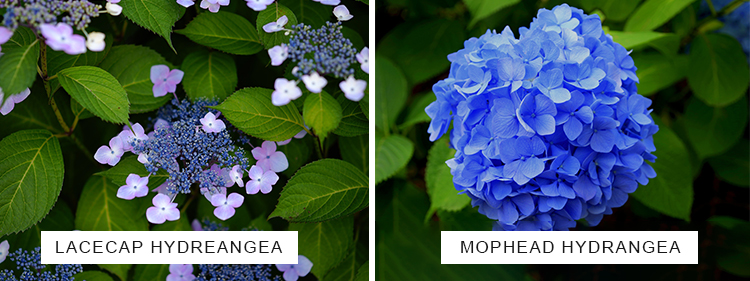
Growing Conditions
Bigleaf Hydrangeas bloom best in partial shade because they need slightly more water than other hydrangeas. Although they can tolerate full sun in the mornings, they need to be protected from the glaring afternoon rays. You can either plant them in an area that is oriented to receive only the morning sun or, if they are planted in an exposed area, you can provide shade covering in the afternoons.
Pruning
Another reason that gardening enthusiasts love Bigleaf Hydrangea is that several of its cultivars can bloom on either old wood or new wood, or, in other words, on either the previous seasons’ stems or the current season’s stems. This characteristic means that its flowers not only have a greater likelihood of blooming every season but also that the decision to prune or not is entirely up to you. It will bloom either way, provided, of course, that it doesn’t experience winter injury, waterlogged roots, or receive too much shade.
However, you need to know which Bigleaf cultivar you are working with because some older varieties only bloom on old wood. Therefore, if you prune it back too much or too late in the season, it won’t bloom the following year. Some of the more easygoing Bigleaf cultivars that bloom on both new and old wood include the ‘Endless Summer’, ‘Red Sensation’, and ‘Double Pink’, which produce pink, red, or blue blooms, as well as ‘Twist-n-Shout’, which is a lacecap, and ‘Blushing Bride’, which bears white flowers.
Additionally, to prevent mildew and other diseases from developing and, if you want to increase the size of the blooms the following season, gently prune back some of the stems to allow for space and air circulation.
Cultivars
Bigleaf Hydrangea is the most popular hydrangea species, and horticulturalists, botanists, and gardening enthusiasts have developed hundreds, actually probably thousands, of different cultivars and hybrids.
We’ll take a look at some of the more unique varieties, starting with one of its most spectacular cultivars: the Harlequin Hydrangea. Producing a breathtaking bloom of deep pink or purple and white bicoloured flowers, this hardy variety can survive in temperatures as low as -20 degrees Celsius, or in USDA Zone 6b, and is guaranteed to be a showstopper in your garden.

The ‘Wedding Gown’ or ‘Dancing Snow’ series is another striking cultivar that only blooms white and green flowers. Unusual for the Bigleaf variety, their flowers do not change colour as they age or when the soil’s pH is altered. White-blooming Bigleaf Hydrangeas are not very common because most naturally produce pink flowers when planted in neutral soil.
Similarly, the flowers of the ‘Pia’, ‘Masja’, and ‘Todi’ cultivars remain staunchly pink regardless of the soil’s pH. Together with the ‘All Summer Beauty’ and ‘Robert’, or more excitingly known as ‘LET’S DANCE MOONLIGHT’ (yes, in all caps), cultivars that can also bloom in similar weather, they will make bright, colourful additions to gardens.
For beautifully arranged preserved blue hydrangeas that will last for many years to come, check out our new dried flower range. Thoughtfully prepared to include Ming fern, heart palm, and other colourfully complementary dried flowers, this delightful arrangement will be absolutely cherished by anyone to whom you send it as a gift.
Hydrangea Anomala | Climbing Hydrangea
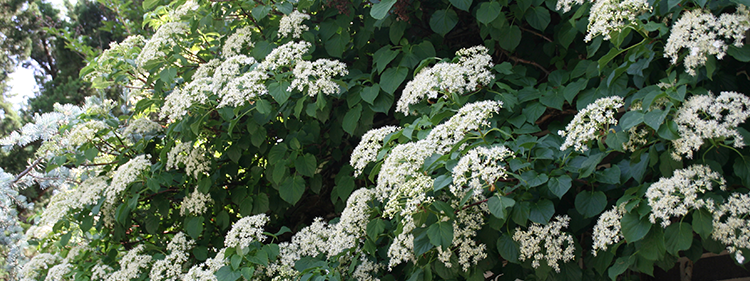
While the Hydrangea Anomala is one of the top six most well-known hydrangea species globally, it is not commonly found in nurseries or gardens. This is because its propagation doesn’t allow for much hybridisation experimentation, and it also isn’t considered as ornamental as other hydrangeas.
Commonly known as the Climbing Hydrangea, this species can reach 16 to 24 metres high by climbing tall trees. It is native to the Himalayas, Nepal, China, Myanmar, and Sakhalin Island and is somewhat of a slow grower, taking about three years to climb and flower. However, when it does, it produces fragrant white flowers in the spring and summer months.
The Climbing Hydrangea’s broad leaves change from a vibrant green in the summer to yellow in the autumn, imbuing it with a soft, golden glow. It uses aerial roots, which develop after a few years, to attach to rocks, trees, and textured walls made from brick, wood, or stone, without damaging them. Therefore, they make suitable decorative enhancements to building walls and other outdoor structures.
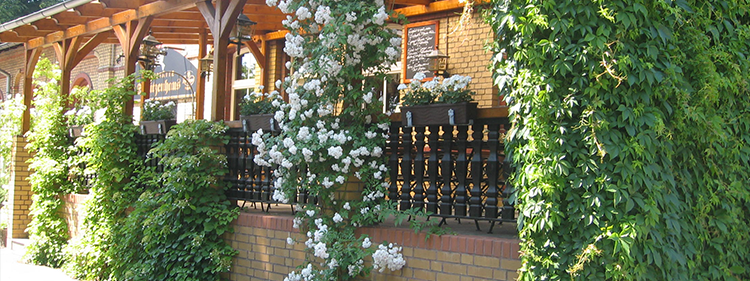
When it does not have objects to climb, Climbing Hydrangea will sprawl across the ground and can spread as far as 200 square feet; however, their bushier growth may not make them the most convenient of ground covers in comparison to other climbers. Something to note is that only the vertical stems can produce flowers; the vines that sprawl on the ground cannot bloom.
Growing Conditions
Found primarily in thick woodlands and mountain slopes, Climbing Hydrangea thrives in more shaded areas and can even grow in full shade; however, it won’t produce as many flowers compared to when it receives sunlight. It is also capable of tolerating full sun as long as its soil has sufficient moisture.
Pruning
Climbing hydrangea needs little to no pruning, except maybe to remove damaged wood or reduce its size. The best time to prune for damaged wood is early spring, while growth-control pruning can take place in the late summer after it flowers. You can also prune vines that protrude much further from the climbing surface than you’d like.
Cultivars
Climbing Hydrangea cultivars are hard to come by because they are not a commonly available or easily variegated species. The ‘Miranda’ and ‘Firefly’ variants, which some botanists consider identical, have yellow borders around their leaves and produce white flowers.
Some people include the fast-growing, pink-flowering climber, Schizophragma Roseum, in the hydrangea species, even calling it the Pink Japanese Climbing Hydrangea. However, although it is a close relative, scientifically, it is not a hydrangea.
Hydrangea Arborescens | Smooth Hydrangea
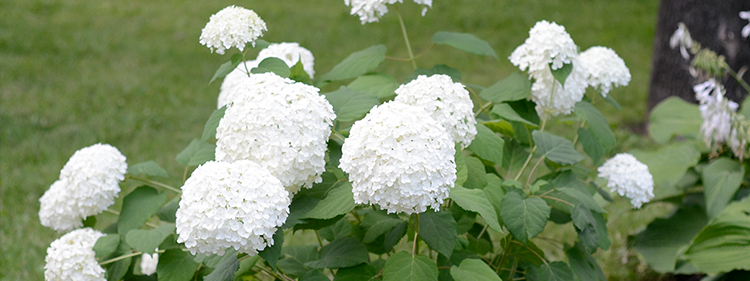
This unassuming-looking hydrangea has two very special characteristics: it is one of only two known species native to North America, and it’s also the only widely available hydrangea that can grow in seven different hardiness zones. In other words, this is a very resilient and unique shrub.
If you like hydrangeas that do not turn colour with age or soil acidity, then the Hydrangea Arborescens is for you. Commonly known as Smooth Hydrangea or seven-bark by Native Americans, it was first documented in the eastern parts of the United States, and since the 1700s, it was known as a purely white flowering species. It took almost 300 years for horticulturists to finally succeed in cultivating the first pink blooming variety called InvincibelleTM Spirit Mountain Hydrangea. Nonetheless, the majority of Smooth Hydrangeas bloom white and remain white throughout their life.
The flowers of the original Smooth Hydrangea grow 15 to 20 cm long in a kind of circular shape called a corymb. However, many of its popular cultivars now produce large round mophead blooms. Given that the shrub generally doesn’t grow very large, reaching an average height of between 90 cm and 1.8 metres tall, the bigger flowers can at times overwhelm the slender stems of some of its cultivars, resulting in occasionally drooping blooms.
Growing Conditions
As an incredibly hardy species that can grow in temperatures as low as -40 degrees Celsius, Smooth Hydrangeas enjoy their partial – not full – shade. They do well with morning sun and can also handle full sun but will need more watering to ensure that the soil remains consistently moist because those are the conditions in which all hydrangeas thrive best.
Pruning
Smooth Hydrangea blooms on new wood, which means that you can prune it quite extensively to encourage stronger stems in the subsequent season. Some experts suggest cutting it back to as little as 10 cm from the ground in late winter or very early spring before the new growth starts. However, there aren’t many reasons to prune it that extensively and it’s important to always make sure that there is a stem base on which the new growth can sprout the following season.
Additionally, to produce a larger bloom, you can also selectively prune some of the new stems in the spring to provide the flowers with more space to grow.
Cultivars
The two most popular Smooth Hydrangea cultivars are ‘Annabelle’ and ‘Grandiflora’. They both produce massive blooms that last for about two months, and which can be so big that it causes the supporting branches to droop. Although the Grandiflora cultivar was developed first, the Annabelle’s stronger stems, which enabled it to hold its blooms more upright, helped it overtake the Grandiflora in popularity.
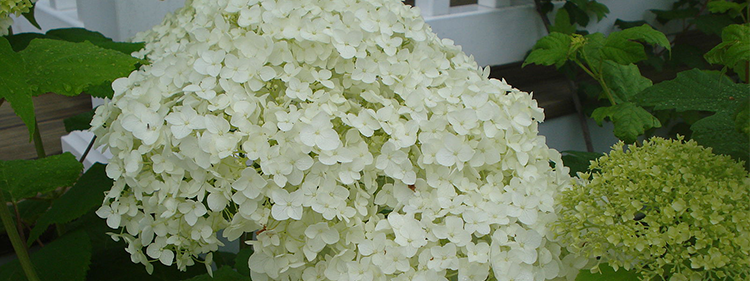
However, the search for even stronger stems did not end there. The ‘Incrediball’ series of cultivars have been developed to be so strong that they remain upright even when drenched with rain. These varieties produce lime green blooms that turn white as they age, and other versions bear pink flowers that turn yellowish-green over time.
To buy a gorgeous bouquet of pure white hydrangeas, visit Flowers Across Melbourne. Skillfully handmade by our expert florists, this bouquet from our new dried flower collection is perfect as a thank you gift or if you simply want to add a spark to your office or living room.
Hydrangea Quercifolia | Oakleaf Hydrangea
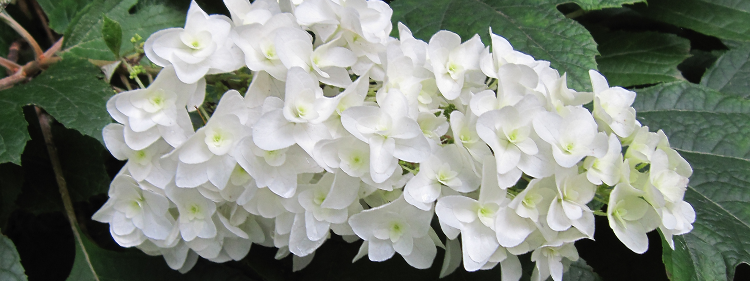
Apart from the Hydrangea Arborescens, the Hydrangea Quercifolia is the only other currently known species native to North America. In Latin, “Quercus” means “oak”, which is the reason this species is also known by the common name of Oakleaf Hydrangea. Although the Hydrangea quercifolia takes after the oak with the shape of its leaves, it doesn’t grow to its impressive height. On average, Oakleaf Hydrangeas grow between 1.2 – 1.8 metres tall and can occasionally reach 2.4 metres.
A general rule of thumb is that white-blooming hydrangeas don’t change colour because they don’t have any colour pigments; therefore, they will always remain white. However, the Hydrangea quercifolia kind of challenges this rule in a different way.
The flowers of this species initially bloom white and then change colour to pink and later brown as they age. This, however, is not due to changes in the soil’s pH levels, which is what causes the flowers of some other hydrangeas to change colour but rather it is most likely related to how it has been designed to attract pollinators. The Oakleaf Hydrangea’s blooms last throughout the summer and even into winter, often resulting in a beautiful bloom cluster that has a mixture of white and pink flowers at some point during the season.
But for many gardeners, the Oakleaf’s main attraction is the turning of its leaves in autumn. Initially a dark green, they change to striking shades of orange, red, burgundy, and purple.
Growing Conditions
The Hydrangea Quercifolia blooms well under the sun and in partial shade. If it is fully exposed to the sun, try to make sure that it is receiving the softer morning sun and not the harsh afternoon sun because prolonged exposure to full sun may cause the colour of the flowers to fade early and to take on a light pink and brown tone, instead of deep pink.
Although the Oakleaf Hydrangea can survive cold climates, its buds can become damaged if the temperature drops below 20 degrees Celsius, often resulting in the hydrangea not producing any blooms the following year.
Pruning
The Oakleaf Hydrangea’s bloom depends on the previous year’s wood; therefore, there is no need to do much pruning. You can lightly remove any wayward, weak, or winter-damaged branches and pretty much leave the rest of it alone. To encourage bigger blooms and ward off any potential mildew, reducing some of the stems is also a good idea.
Cultivars
There are about fifteen different cultivars of the Hydrangea quercifolia designed to grow to different heights, shapes, leaf colour, and bloom size, among many other characteristics.
The ‘Ruby Slippers’ variant, for example, only grows to between 0.9 to 1.2 metres, while the ‘Sike’s Dwarf’ breed grows even shorter to only 0.6 to 0.9 metres tall, to work better as hedges. As its name may suggest, the flowers of the ‘Ruby Slippers’ become a dazzling red colour as they age, while those of the ‘Alice’ and ‘Amethyst’ cultivars turn a stunning deeper pink over the course of the season in comparison to other variants of the Oakleaf Hydrangea.
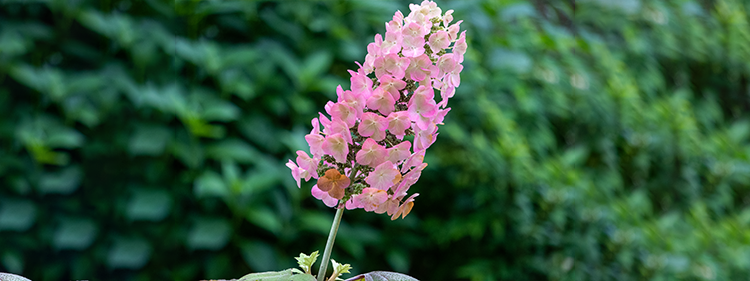
On the subject of colour, the leaves of the ‘Little Honey’ put on quite a show for its growers. In contrast to other Oakleaf Hydrangeas, the leaves of this cultivar are golden yellow, developing to a deep yellow-green and eventually to red in the autumn.
Moving to bloom size, if you really like the flower heads of your hydrangeas to look exceptionally full and dense, go for the ‘Vaughn’s Lillie’ cultivar. Its flowers literally fill every inch of its stems to give a wonderfully rich and bountiful look to its bloom. However, the ‘Snowflake’ and ‘Gatsby’s Star’ variants make it one step further and produce incredible double blooms that can be so heavy that the stems sag under their weight.
Speaking of full blooms, our Snow Cloud arrangement features a lovely, thick flower head of preserved white hydrangea from our new dried flowers line. Exquisitely arranged, it will make a striking centrepiece for a special occasion or add an elegant touch to your interior décor that will last for years to come.
Hydrangea Serrata | Mountain Hydrangea

Bearing a very similar look to, and the characteristics of, the Hydrangea Macrophylla. Including the ability of its flowers to change colour depending on soil pH levels. The Hydrangea Serrata was previously known as Hydrangea Macrophylla Acuminata. However, botanists decided to re-classify it as a separate species. Mainly due to its thinner serrated leaves and its smaller and more compact size compared to the Hydrangea Macrophylla.
Commonly referred to as Mountain Hydrangea in English. This species is also known as San-songbook in Korea and Yama Ajisai in Japan. Where it occurs naturally in woodland areas. The leaves of the Mountain Hydrangea have a natural sweetener. Locals in these areas use it to make sweet herbal teas. Leading them to label this plant the Tea of Heaven.
Mountain Hydrangea doesn’t grow very tall, often reaching between 0.6 and 1.2 metres. Making it an ideal accent or border plant. However, care needs to be taken with its leaves. They are more vulnerable to developing powdery mildew and leaf spot. This is due to their thinner texture. Clearing away all fallen leaves at the end of the current season and pruning some of the stems and leaves is ideal. This is because it increases airflow through the plant. This will reduce the chances of these diseases occurring in the following season.
Growing Conditions
The Mountain Hydrangea grows well in the morning sun, partial shade, and shade. It can handle cool winters better than the Bigleaf Hydrangea, tolerating temperatures as low as -25 degrees Celsius. However, during harsh winters, make sure to provide it with winter protection and insulation if possible to prevent wood damage.
Pruning
Similar to the Bigleaf Hydrangea, the Mountain Hydrangea also grows on old wood. Therefore, minimal pruning is required. You can prune its stems and branches after flowering. In early spring, remove any stems that have been damaged by the winter. It is safe to prune up to one-third of the wood per year after the plant has flowered.
Cultivars
There are many cultivars of the Mountain Hydrangea around the world. In Japan alone, there exist hundreds of locally developed varieties. Most produce either pink or blue flowers depending on the soil’s acidity. Additionally, they do not differ much from each other, except perhaps in height and the colours of their fertile florets. However, there are a few variants that stand out.
The ‘Rosalba’, ‘Grayswood’, ‘Beni-Gaku’, and ‘Shirofuji’ variants are unusual for Mountain Hydrangea species. This is because their flowers are not influenced by changes in the soil’s pH. Therefore, they cannot produce blue flowers. The blooms of the ‘Rosalba’, ‘Grayswood’, and ‘Beni-Gaku’ start off as white. Eventually they change to various shades of pink over the course of the blooming season. The ‘Shirofuji’, on the other hand, remains white throughout.
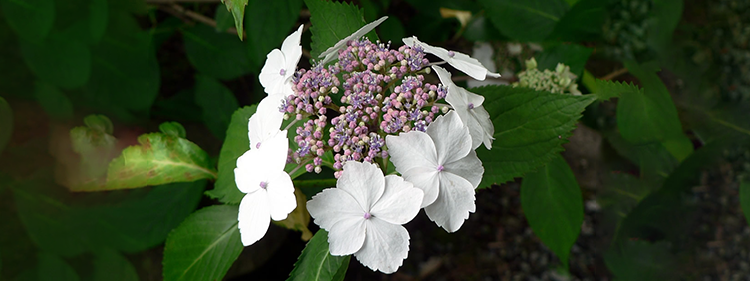
The ‘Miyama Yae-Murasaki’ cultivar, also known as Purple TiersTM. It is particularly striking in that it produces clusters of double flowers that bloom on top of each other. Depending on the soil, the flowers can either be deep purple, pink, or blue in colour.
Pink hydrangeas are said to symbolise heartfelt emotions. Express your everlasting love with everlasting pink hydrangea from our new dried flower range. You can accompany this colourful bouquet with chocolates, wine or champagne, books, or skincare products. Among many other unique gifts from our online shop.

Hydrangea Paniculata | Panicle Hydrangea
One of the most winter hardy and tolerant of all the hydrangeas. The Hydrangea Paniculata can grow in temperatures as low as -40 degrees Celsius, or USDA Zone 3. Native to Japan, China, Korea, and the Russian islands of Sakhalin and Kuril. Its name refers to its flowers’ conical, or panicle, arrangement.
The Hydrangea Paniculata can regularly grow to 4.6 metres in height and, in some cases, even reach 6 metres. It produces white flowers that are typically about 15 to 20 cm long. Although some of its cultivars, such as ‘GrandiFlora’, can produce blooms as long as 46 inches. As the flowers age, they change to either a light pink or green colour. Depending on the variety and sun exposure.
Overall, the Hydrangea Paniculata is a pretty dependable plant that can grow in most soils and conditions without much fuss. Its unfussiness is even evidenced in its common name, which is simply Panicle Hydrangea. Nothing too fancy. With its fragrant flowers and average height, this species can work well as a hedge. Some of its cultivars can even be shaped into a gorgeous flower-blooming tree.
Growing Conditions
Given its hardiness, the Panicle Hydrangea does well in slightly more weather extremes than other Hydrangeas. Although it prefers its morning sun, it can also tolerate full sun as long as it receives adequate water. However, the blooms of some of its cultivars will last longer. Its colours remain more vibrant if planted in partial shade.
One example is the ‘Vanilla Strawberry’ variety. Botanists found that its vibrancy would diminish two to three weeks earlier. In addition, its colour change to brown instead of deep pink if planted in full sun compared to partial shade.
Pruning
Panicle Hydrangea bloom on new woo. Which means that you can prune it to your heart’s content. Because the next season’s growth depends on the new stems and not the previous year’s stems. Make sure, that you don’t prune it all the way to the ground. This way the new stems won’t have a base on which they can grow.
You can also encourage your Paniculata to produce larger flower panicles by slightly pruning about 5 to 10 main stems. Thereby providing space for the flowers to grow the following season. Pruning is best done in early spring.
This species is also known for being able to grow into a most spectacular hydrangea tree. The ‘GrandiFlora’ is the best cultivar for the job. After it has established, select the strongest stem you can find and remove all other stems. That way the plant will direct all of its energy towards growing it instead of multiple others. This will enable the selected stem to grow even thicker and stronger. Tie the main stem to a stake and regularly remove other shoots that come up from the ground. However, you can leave side branches that grow from the main stem. This process may take several years, but you’ll soon have a striking Hydrangea tree in your garden.
Cultivars
The most popular and oldest Hydrangea Paniculata cultivar is ‘the GrandiFlora’, developed in the 1800s. It is also known as the PeeGee. It is so synonymous with the Hydrangea Paniculata that the entire species is generally referred to as PeeGee Hydrangea.
Most of the Hydrangea Paniculata cultivars produce white or white-green blooms. These change to various shades of pink and red as they age. The main differences in the breeds are in height. The ‘Limelight’ cultivar growing to 3 metres and the ‘Little Lime’ growing only to 1.5 metres, the size of their blooms, and the months in which they bloom. ‘Quick Fire’ is the earliest bloomer of the species, producing flowers right at the beginning of summer.
To add extra interest to your garden, check out ‘Pinky Winky’. This cultivar continues to bloom throughout the season, often resulting in multicoloured pink and white flowers in the same bloom. As the older flowers age and change to pink. Newer white flowers grow on the tip of the panicle resulting in both colours occurring together.

Planting Hydrangeas
The number one rule for growing hydrangeas is to ensure that the soil is always moist. Hydrangeas are not even a little bit drought-tolerant and do not do well with dry soil. Therefore, a careful balance must be struck with ensuring that they receive enough water. But not too much that their roots become soggy because then the roots will rot.
Mulch and compost are very helpful in maintaining sufficient moisture and drainage in the soil. To enhance water drainage, you can also consider raising your garden bed. This is to ensure that waterlogging, which leads to root rot, doesn’t occur.
Hydrangeas also prefer a slightly more acidic, fertile environment. With some species and cultivars, such as the Bigleaf and Climbing Hydrangeas, able to tolerate more acidic levels than others. It is essential to check the pH levels of your soil before planting. Adjust them accordingly, if needed, to ensure that you’re providing the best environment for your shrub to grow and thrive.

Watering Hydrangeas
As its name indicates, hydrangeas love water. Due to its larger leaves, the Bigleaf Hydrangea requires the most water out of all the hydrangea species, while the Oakleaf Hydrangea has one of the lowest water needs due to its extreme sensitivity to soggy soil and root rot.
Watering needs will vary depending on how much sun your hydrangea receives and soil type. More water is necessary when they are exposed to full sun and if the soil is finer. If you notice that your hydrangea’s leaves are starting to droop, it means that it needs more water. Check soil moisture at least once a week to ensure that it remains damp but not wet. You can insert a stick into the ground, and if it emerges dry, that means it needs water promptly.
Hydrangea Blooming Problems
Hydrangeas usually don’t bloom due to four main things: imbalances in soil composition, pruning at the wrong time of the season, too much shade, or winter damage to its wood. If you appropriately address each of these issues when planting and caring for your hydrangea, you will enjoy a vibrant garden full of beautifully blooming hydrangeas every season.
Visit Flowers Across Melbourne to find out more about our new dried flowers range. Handmade and providing same-day delivery anywhere in Melbourne, our flower arrangements are designed to make everyday special.

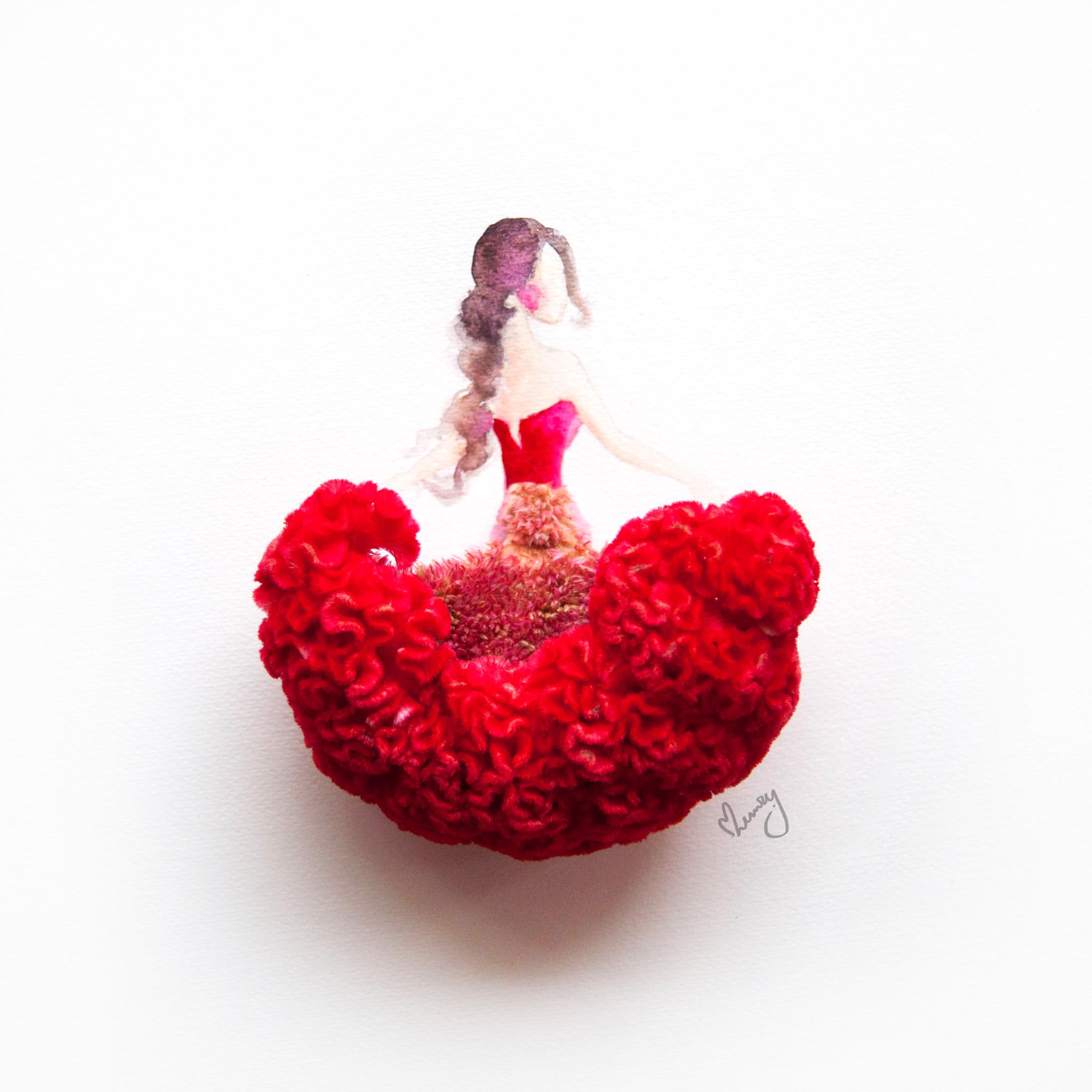
No Comments